Green architecture – California Academy of Sciences
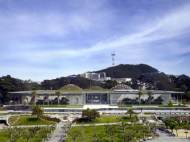 In this article we’re going to write about a beautiful green architecture that is worth visiting, and it’s the California Academy of Sciences in Golden Gate Park, San Francisco. A crowning achievement of sustainable architecture, the Academy will house 38,000 live animals and it received LEED platinum award. It is currently the only institution in the world to feature an aquarium, a natural history museum, a living rainforest, a planetarium, and world-class research and education programs – all housed under a 2.5 acre green roof.
In this article we’re going to write about a beautiful green architecture that is worth visiting, and it’s the California Academy of Sciences in Golden Gate Park, San Francisco. A crowning achievement of sustainable architecture, the Academy will house 38,000 live animals and it received LEED platinum award. It is currently the only institution in the world to feature an aquarium, a natural history museum, a living rainforest, a planetarium, and world-class research and education programs – all housed under a 2.5 acre green roof.
Architect Renzo Piano achieved this in his design for the Living Roof. Not only does the green rooftop canopy visually connect the building to the park landscape, but it also provides significant gains in heating and cooling efficiency. The 15cm of soil substrate on the roof acts as natural insulation, and it also keeps approximately 13.5 million liters of rainwater per year from becoming storm water. The steep slopes of the roof also act as a natural ventilation system, channeling cool air into the open-air plaza on sunny days. The skylights perform as both ambient light sources and a cooling system, automatically opening on warm days to vent hot air from the building.
Besides the soil insulation, the building has a type of thick cotton batting made from recycled blue jeans. This material provides an organic alternative to formaldehyde-laden insulation materials. Recycled denim insulation holds more heat and absorbs sound better than spun fiberglass insulation. It is also safer to handle. Even when denim insulation is treated with fire retardants and fungicides to prevent mildew, it is still easier to work with and doesn’t require installers to wear protective clothing or respirators.
The Academy has a radiant heating system installed in the museum’s floors. Tubes embedded in the concrete floor carry hot water that warms the floor. The proximity of the heat to the people who need it reduces the building’s energy need by an estimated 10%.
Surrounding the Living Roof is a large glass canopy with a decorative band of 60,000 photovoltaic cells. These solar panels generate approximately 213,000 kilowatt-hours of energy per year and provide up to 10% of the Academy’s electricity need. The use of solar power will prevent the release of 183 tons of greenhouse gas emission into the air.
The expansive, floor-to-ceiling walls of glass enable 90% of the building’s interior offices to use lighting from natural sources. The glass used in these perimeter walls surrounding the public floor were specially constructed with low-iron content. This feature removes a common green tint, providing exceptional clarity. From almost any point inside the museum, visitors will be able to see the park outside in all its seasonal colors.
Skylights, providing natural light to the rainforest and aquarium, are designed to open and close automatically. As hot air rises throughout the day, the skylights will open to allow hot air out from the top of the Academy while louvers below draw in cool air to the lower floors without the need for huge fans or chemical coolants.
And the interior of the Academy is just beautiful. The entrance doors lead to an immense inner courtyard that suffuses the entire structure with light. A transparent four-story dome in the Museum’s east wing houses the Academy’s stunning “Rainforests of the World” exhibit, complete with flying birds, insects, butterflies, and frogs hidden in the flourishing green vegetation.
From the peak of the rainforest you can go into the lower level down by using a glass elevator into the Academy’s aquatic exhibits. An incredible acrylic tunnel serves as the gateway, exposing the inner workings of the Amazonian flooded forest. The Academy’s Philippine aquarium is home to the largest indoor coral reef exhibit in the world. The 802,000 liters tank contains over two thousand species of fish, and the reef was grown entirely from pieces of coral that were either cultivated or purchased from other aquariums.
Conceived as a “celebration of life”, the exhibit will grow and change as its ecosystem develops – in three to five years the dome’s flora will enshroud it beneath an ethereal rainforest canopy. It also features a café and pleasant gardens where visitors can rest and refresh. Overall, it is a truly green place with green architecture solutions which you simply have to visit sometimes. Just make sure you check do they have the tickets for the particular day you would like to visit them, since some days are already taken.

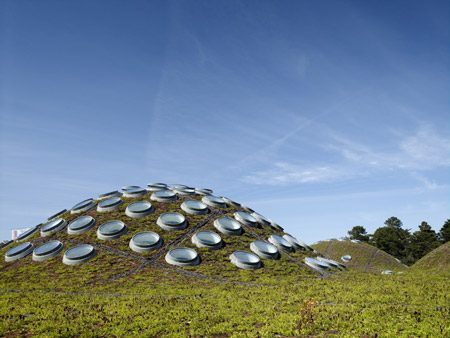
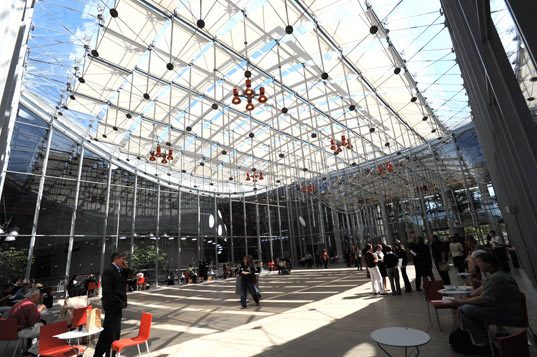
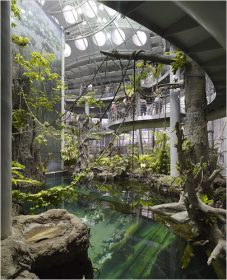
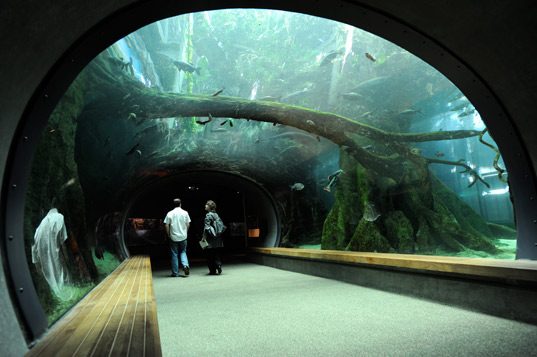








I continue to be confused about green and sustainability claims for denim insulation. People who certainly appear to be intelligent and well-intentioned never bother to consider that there would appear to be no support for many of those claims. That said, let’s look at the claims in this article.
– “. . . made from recycled blue jeans.” Denim insulation is made from post-industrial denim scraps, some of which is sourced from Mexico. http://www.bondedlogic.com/ultratouch-cotton.htm
– “organic alternative” Just because a product is plant derived does not automatically mean that it is better. Are pesticides and herbicides used to grow the cotton? How much water is needed for the cotton and what water pollution is generated? Mexico is not known for its strong environmental laws. Nor is denim insulation “organic” unless there is substantiation that the cotton was cultivated according to well-established organic agriculture.
– “formaldehyde-laden insulation materials” Johns Manville’s entire line of fiber glass building insulation is made without any added formaldehyde. Also, some denim is treated with a formaldehyde-based resin to impart wrinkle-free properties. Are there test data to confirm there is no formaldehyde added to the denim?
– “holds more heat and absorbs sound better than spun fiberglass insulation.” I know of no data to substantiate this claim.
– “safer to handle” How is handling safety measured and where are the data to support this claim? Remember that if a denim insulation batt weighs ten pounds, fully 1.5 pound of that is added fire retardant chemicals.
– “doesn’t require installers to wear protective clothing or respirators.” Are people aware what the MSDS for this product states? In section VIII Control Measures the MSDS states the following: “Respiratory Protection (Specify Type) OSHA APPROVED AIR MASK.” See http://www.bondedlogic.com/documents/UltraTouchMSDS.pdf
– “treated with fire retardants and fungicides to prevent mildew” Two claims are usually made for denim insulation – it is safe and the added fire retardant chemicals (15% by weight) are strong enough to prevent mildew and kills pests. Are these claims inconsistent? What do the data show?
– denim insulation is also touted as more sustainable, but again I know of no data to support such a claim. What are the conditions of the agricultural workers (who plant, cultivate and harvest the cotton) and the textile workers. Again, Mexico is not known for its strong labor laws. What pesticides and herbicides are used in the cotton cultivation? How much water is needed and how much water pollution is generated? Much agriculture is carbon intensive, especially if chemical fertilizer is used. And do the cotton farms have strict environmental permits? What chemicals are used to dye the denim? What water pollution is generated by the denim manufacturing process? What do the data show?
Full disclosure: I work for Johns Manville, which makes an entire line of Formaldehyde-FreeTM fiber glass building insulation. Our factories in the US and Canada operate pursuant to strict environmental permits and our workers are full-time employees with full benefits. Our factories operate in a culture of maximum health and safety. Fiber glass is naturally non-combustible and does not need fire retardant chemicals. JM’s insulation contains 20% post-consumer recycled content. And JM has been recognized as a Climate Action Leader.
author
Fiberglass insulation is made of silica sand and recycled glass, both abundant resources. The U.S. Environmental Protection Agency (EPA) requires that 20 percent of materials come from recycled sources, either post-consumer or post-industrial, and some products contain up to 40 percent.
Producing fiberglass insulation requires melting the materials in a fossil fuel–burning furnace, which consumes substantial amounts of energy and generates greater amounts of air pollution than the manufacture of other insulation types.
If installed properly, there is little danger of inhaling fibers, which are throat, eye, and skin irritants. Although the Occupational Safety and Health Administration still requires cancer warning labels on fiberglass insulation products, the American Lung Association states that glass fibers are not linked to increased cancer risk, even among glass fiber manufacturing workers.
Fibers can escape into the air during installation—or if duct-work is not sealed properly, and that can become a problem for the residents. Because of the concern that fiberglass emits phenol-formaldehyde, some manufacturers have switched to nontoxic acrylic binders or have had their products certified by Greenguard as low-emitting products. (A low-emitting product has half of what the EPA considers elevated formaldehyde levels.)
Loose-fill fiberglass seals air spaces best since it is blown in, preventing air movement and heat loss. Low-density batts are most commonly used, but can lose up to 50 percent of their R-value in cold climates due to moisture infiltration. High-density batts cost more, but have a higher R-value; they will pay back the difference in lower energy bills, especially in cold climates.
Denim insulation, unlike pure natural cotton, is made from recycled materials, thus reducing a whole lot of new pollution emissions, keeping them at current levels. The sound insulation property is absolutely true, since denim insulation found its use even in acoustic sound barrier uses (as main or secondary sound insulator and echo canceler). The warmth property depends on particular insulation types and treatment. The fire-retardant is borate based. It is a non-toxic material (used as eye-wash for newborns) that also acts as a great pest inhibitor.
Hope I answered your questions.